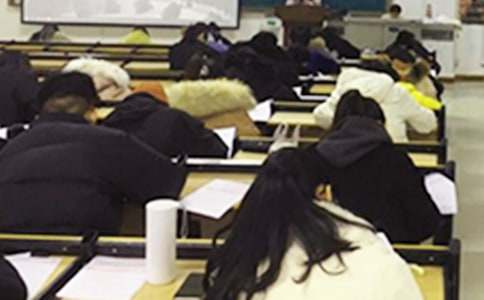- 相关推荐
2017公共英语四级考试题阅读精选
failure is the mother of success,以下是小编为大家搜索整理的2017公共英语四级考试题阅读精选,希望能给大家带来帮助!更多精彩内容请及时关注我们应届毕业生考试网!

The following paragraphs are given in a wrong order. For Questions 51 —— 55, you are re-
quired to reorganize these paragraphs into a coherent text by choosing from the list A.——[G ] and filling them into the numbered boxes. Paragraphs A. and [ E] have been correctly placed. Mark your answers on the ANSWER SHEET.
A. Some archaeological sites have always been easily observable--for example, the Parthenon in Athens, Greece, the pyramids of Giza in Egypt; and the megaliths of Stonehenge in southern
England. But these sites are exceptions to the norm. Most archaeological sites have been located by means of careful searching, while many others have been discovered by accident.Olduvai Gorge, an early hominid site in Tanzania, was found by a butterfly hunter who literally fell into its deep valley in 1911. Thousands of Aztec artifacts came to light during the digging of the Mexico City subway in the 1970s.
B.In another case, American archaeologists Rene Million and George Cow gill spent years systematically mapping the entire city of Teotihuacan in the Valley of Mexico near what is now
Mexico City. At its peak around AD 600, this city was one of the largest human settlements in the world. The researchers mapped not only the city' s vast and ornate ceremonial areas,but also hundreds of simpler apartment complexes where common people lived.
C. How do archaeologists know where to find what they are looking for when there is nothing visible on the surface of the ground? Typically, they survey and sample (make test excavations on) large areas of terrain to determine where excavation will yield useful information.
Surveys and test samples have also become important for understanding the larger landscapes that contain archaeological sites.
D. Surveys can cover a single large settlement or entire landscapes. In one case, many researchers working around the ancient Maya city of Cohan, Honduras, have located hundreds of small rural villages and individual dwellings by using aerial photographs and by making surveys on foot. The resulting settlement maps show how the distribution and density of the rural population around the city changed dramatically between AD 500 and 850, when Cohan collapsed.
[ E ] To find their sites, archaeologists today rely heavily on systematic survey methods and a variety of high-technology tools and techniques. Airborne technology.es, such as different types of radar and photographic equipment carried by airplanes or spacecraft, allow archaeologists to learn about what lies beneath the ground without digging. Aerial surveys locate general areas of interest or larger buried features, such as ancient buildings or fields.
[ F] Most archaeological sites, however, are discovered by archaeologists who have set out to look for them. Such searches can take years. British archaeologist Howard Carter knew that the tomb of the Egyptian pharaoh Stank human existed from information found in other sites. Carter sifted through rubble in the Valley of the Kings for seven years before he located the tomb in 1922. In the late 1800s British archaeologist Sir Arthur Evan combed antique dealers' stores in Athens, Greece. He was searching for tiny engraved seals attributed to the ancient
Mycenaean culture that dominated Greece from the 1400s to 1200s BC. Evans' s interpretations of these engravings eventually led him to find the Minoan palace at Knossos (Knoss6s) on the island of Crete, in 1900.
[ G] Ground surveys allow archaeologists to pinpoint the places where digs will be successful.Most ground surveys involve a lot of walking, looking for surface clues such as small fragments of pottery. They often include a certain amount of digging to test for buried materials at selected points across a landscape. Archaeologists also may locate buried remains by using such technologies as ground radar, magnetic field recording, and metal detectors. Archaeologists commonly use computers to map sites and the landscapes around sites. Two and three dimensional maps are helpful tools in planning excavations, illustrating how sites look, and n resenting the results of archaeological research.
参考译文
当地面上什么东西都看不到,考古学家怎么知道该去哪里寻找他们要找的东西呢?通常,他们会在大片区域做测量和取样(做实验性的挖掘)来决定在哪里挖掘会得到最有用的信息。测量和取样对于了解包含考古遗址的更广阔地貌也变得非常重要。
一些考古遗址很容易被发现一例如,希腊雅典的帕特农神庙,埃及的吉萨金字塔以及英格兰南部的巨石阵。但是这些遗址是特例。,大多数考古遗址是通过认真的搜寻才找到的,而还有许多其他的遗址是意外发观的。奥杜威峡谷,坦桑尼亚的早期原始人类遗址,是被一个捉蝴蝶的人发现的,他l911年跌入奥杜威峡谷的深谷。数以千计的阿兹特克文物是在20世纪70年代挖掘墨西哥城的地铁时发现的。
然而,大多数考古遗址都是在考古学家的努力寻找之下发现的。这样的寻找可能需要好几年的时间。英国考古学家霍华德·卡特通过在其他遗址得到的信息得知埃及法老图坦卡蒙墓的存在。卡特在帝王谷的碎石中仔细搜寻了七年,终于在1922年找到了他的坟墓。在19世纪末期.英国考古学家阿瑟·埃文爵士把希腊雅典的古董商店梳理了一遍。他在寻找于公元前l5世纪到l3世纪统治希腊的古迈锡尼文明的小印章。埃文对这些雕刻的解读最终使他1900年发现了克里特岛的克诺索斯的米诺斯王宫。
为了发现遗址,考古学家现在严重依赖系统的测量方法和各种各样的高科技工具和技术。机载技术,例如由飞机或太空飞船携带的各种各样的雷达和拍照设备使考古学家们能够无需挖掘就了解到地下埋藏着什么。航空勘测可以发现遗址所在的大致区域,或者更大的埋藏特征,例如古建筑或田野。
地面测量使考古学家精确地找到挖掘应该会成功的地点。大多数地面测量包括大量的步行、寻找地面的线索,例如陶器的细小碎片。它们经常包括在一片区域内选取定点进行挖掘取样。考古学家还能通过使用诸如地面雷达、磁场纪录和金属探测器等技术找到遗迹。考古学家通常使用计算机绘制遗址地图以及附近的地形图。二维或三维的地图对规划挖掘、展示遗址样貌和展示考古研究结果来说都是有用的工具。
测量可能包括单一的大型定居点或者完整的地形。曾经.许多研究者通过航空拍摄和徒步测量,在洪都拉斯的古代科潘玛雅城发现了几百处小村庄和定居点。最后生成的定居地地图展示了当科潘瓦解时,围绕城市的农村人口的分布和密度如何在公元500年至850年之间戏剧性地变迁。
在另外一个案例中,美国考古学家雷内·米利翁和乔治·考吉尔花费数年时间系统地绘制了位于墨西哥峡谷、邻近今天墨西哥城所在地的特奥蒂瓦坎古城的地图。在公元600年前后,这座古城处于鼎盛时期,并成为当时全世界最大的人类定居点之一。研究者不仅绘制了城市广阔而华丽的礼仪区域,还包括了几百处普通人居住的简单的公寓建筑。
答案及解析
51.C【解析】本题是总分关系题。该空格位于文章的起始。空格之后的A项提到“一些考古遗址很容易发现”,“但是这些遗址是特例。大多数考古遗址是通过认真的搜寻才找到的,而许多其他的遗址是意外发现的。”而E项提到“为了发现遗址,考古学家现在严重依赖系统的测量方法和各种各样的高科技工具和技术”,可见空格处所填入的句子应该起到总领全文的作用,即概括地
说明考古学家使用测量和取样的方法进行考古发现,浏览所有选项,只有C项适合作为主题段,先提出全文要解决的问题,然后给出总括性的解释。
52.F【解析】本题是顺接关系题。该空格位于全文第三段。第二段作者提到“一些考古遗址很容易发现”,“但是这些遗址是特例”并举例说明肉眼可见的遗址,以及“大多数考古遗址是通过认真的搜寻才找到的,而许多其他的遗址是意外发现的”,并举例说明、意外发现的遗址,而第四段E段转而谈论考古学家运用何种方法进行考古发现,由此可以推断此段意义与前段构成顺接关系,空格处可能会举例说明“大多数考古遗址是通过认真的搜寻才找到的”,F项提到“大多数考古遗址都是在考古学家的努力寻找之下发现的。这样的寻找可能需要好几年的时间”,并用两个例子进行支撑。
53.G【解析】本题是顺接关系题。该空格位于全文第五段。空格之前的E段指出“为了发现遗址,考古学家现在严重依赖系统的测量方法和各种各样的高科技工具和技术”,并举例说明了“机载技术”和“航空勘测”两种测量方法,而G段继续介绍地面测量和计算机绘制遗址地图以及附近的地形图在考古过程中的.重要作用,与前段构成顺接关系。‘
54.D【解析】本题是顺接关系题。该段位于全文第六段。空格之前已经介绍了除了少数特例之外,大多数考古遗址都是在考古学家的努力寻找之下发现的,并且介绍了考古学家运用各种测量方法和先进的科学技术做出考古发现,而D段继续介绍测量的不同方式,包括单一的定居点或者包括完整的地域风貌,并举例说明考古学家如何通过测绘单一定居点的方式完成考古发现。
55.B【解析】本题是顺接关系题。该空格位于全文第七段。空格之前的D段已经介绍了考古测量可以包括单一的定居点或者完整的地域风貌,并举例说明考古学家如何通过测绘单一定居点的方式完成考古发现,B项中的in another case正是空格之前D段中in one case的顺接关键词,同时该段也举例介绍了另外一种测量方式,即通过测绘完整的地域风貌完成考古发现。
【公共英语四级考试题阅读】相关文章:
2017年公共英语阅读考试题03-29
2017公共英语pets阅读全真考试题11-18
2017公共英语PETS四级阅读欣赏12-03
公共英语四级阅读模拟试题10-26
公共英语pets四级阅读预测题03-27
最新公共英语四级考试备考试题03-02
2017年公共英语pets四级备考试题11-17
2017公共英语PETS四级阅读训练题12-03
2017公共英语四级阅读备考指导12-02